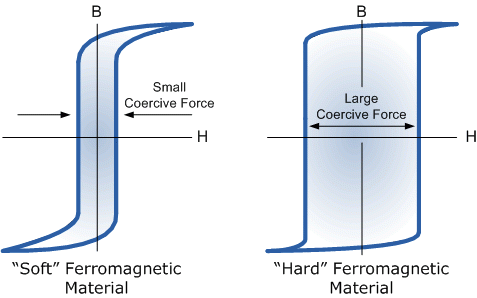Electromagnetism Resource
3. Electric and Magnetic Fields
3.4. Magnetising Force
Magnets and magnetic substances respond to a magnetising force.
Magnetising force is represented by \( H \), and has the unit A.m-1. The relationship between magnetising force \( H \) and flux density \( B \) for "soft" magnetic materials is described by:
\( B = \mu H = \mu_0 \mu_{\mathrm{r}} H \)
where \( B \) is the magnetic field (T), \( \mu \) is the magnetic permeability (H.m-1), and \( H \) is the magnetising force (At.m-1).
The magnetising force is provided by passing current through a wire or similar. The unit has the value amp-turns per metre, in the sense that the magnetising force is amplified by the number of turns of a coil of wire. Physically the unit is the same as A.m-1.
The unit henry is the ratio of magnetic flux to current i.e. 1 H = 1 Wb.A-1. So the higher the permeability, the stronger the magnetic flux you can create for a given amount of current.
Every material has its own response of magnetic field to magnetising force. Two types of magnetic materials are shown below.
Hard and Soft Magnetic Materials
The response of a magnetic material to a magnetising material is described using a B-H curve.
The material on the left is a soft magnetic material.
The reason is the it takes a relatively small value of \( H \) is required to reverse the magnetic field.
Soft magnetic materials are excellent when the magnetic field is changed frequently, such as in transformers.
Soft magnetic materials are a poor choice for permanent magnets, as the residual magnetic field is weak.
In contrast, a hard magnetic material requires a high value of \( H \) to reverse the magnetic field.
Hard magnetic materials are excellent when the magnetic field needs to be retained, such as in permanent magnets.
Hard magnetic materials are a poor choice when the magnetic field is changed frequently, such as in transformers.
The image below shows two B-H curves. The one on the left is for a soft magnetic material, the one on the right is for a hard magnetic material.

Another notable feature is the levelling of of the curve at high values of positive or negative \( H \). This is called magnetic saturation, and results in a drop in permeability. Most electrical steels saturate at a flux density of 1.2-2.2 T.